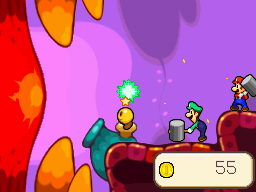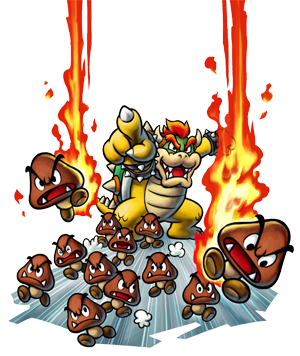There’s been a lot in gaming press, blogs, and messageboards lately about how Japanese RPGs are stagnating. With the arrival, en masse of high-quality Western RPGs on consoles, history is repeating itself. Remember what happened when console gamers discovered what good first-person shooters and built-in modding/customizing tools were like? Halo was not a big deal to those of us who had previously played everything from Wolfenstein 3D onward, and Little Big Planet looked nice, but was it really going to revolutionize things when powerful—but not overly intimidating—modding tools like UnrealEd were old news?
Anyway, like I said, there’s a lot of whining about how JRPGs have gone downhill, and some people think that the best way to fix them is to, generally, make them more Western. Such homogenization isn’t the best approach (and wouldn’t make the core JRPG consumer base happy), but what is? While some JRPG series (most notably Dragon Quest, Tales, and Pokemon) soldier on with high-quality, well-received main entries, other games have been seeking different approaches. There’ve been some novel experiments (Valkyria Chronicles, The World Ends With You), but more commonly, we’ve seen a lot of hybrids.
Hybrid RPGs are not easy to pigeonhole, and they’ve always kinda-sorta been around in one form or another, but the past few years have really seen them come into their own. For evidence of this, RPGamer’s Best of 2009 Awards is worth a look. While more traditional RPG fare took the top prizes, many genre blends popped up in other categories: SRPG/shmup Knights in the Nightmare, RPG/microgame mashup Half-Minute Hero, dungeon crawler/farming sim Rune Factory Frontier, and so on. The phenomenon isn’t limited to Japan, either, one of the more recent examples being the Western-developed puzzle RPG Might & Magic: Clash of Heroes, likewise mentioned in the Best of 2009. Clearly, RPGs mixing with other genres is a growing trend, and going by the quality of the hybrids I’ve played so far, it’s one that I personally would like to see continue.
 One of the original hybrid RPG stars has been, not unexpectedly, Mario. First in Super Mario RPG, then in the Paper Mario and Mario & Luigi games, the portly Italian plumber’s RPG adventures intermingle with the precise jumping and timing that define his platforming exploits. The Mario & Luigi series in particular adds an extra layer of challenge by having you control both Mario Bros. on the field at the same time, and eventually, special moves become available that can only be pulled off when the two are together. The second game, Partners in Time quadruples the party when Baby Mario and Baby Luigi join their older selves on the quest. This was also the first game in the series to appear on the Nintendo DS (the original was on the Game Boy Advance), occasionally reserving the top screen as the babies’ domain, with special areas only they can explore, for when they aren’t riding piggyback on the adults.
One of the original hybrid RPG stars has been, not unexpectedly, Mario. First in Super Mario RPG, then in the Paper Mario and Mario & Luigi games, the portly Italian plumber’s RPG adventures intermingle with the precise jumping and timing that define his platforming exploits. The Mario & Luigi series in particular adds an extra layer of challenge by having you control both Mario Bros. on the field at the same time, and eventually, special moves become available that can only be pulled off when the two are together. The second game, Partners in Time quadruples the party when Baby Mario and Baby Luigi join their older selves on the quest. This was also the first game in the series to appear on the Nintendo DS (the original was on the Game Boy Advance), occasionally reserving the top screen as the babies’ domain, with special areas only they can explore, for when they aren’t riding piggyback on the adults.
The latest Mario & Luigi game (and the last Mario RPG ever made that I had left to play), the Fall 2009 release Bowser’s Inside Story, is likewise on the DS, but this time, the party is reduced to three: Mario, Luigi, and perennial bad guy Bowser. The basic plot is that the Mushroom Kingdom has been hit hard by a disease called the Blorbs, which causes the local Toads to swell up into obese giants. Meanwhile, Bowser is, yet again, planning to kidnap Princess Peach when, along the way, he eats a strange mushroom which causes him to swallow up the Princess, Mario, Luigi, and half the Kingdom. Mixed in with all this is the delightfully mad Fawful, Cackletta’s henchman from the first game who comes back as a full-fledged villain here. While Mario and Luigi explore Bowser’s body to try and find a way out, Bowser commences on his own journey. What comes out of their adventures is one of the strangest symbiotic relationships the Mario canon has seen yet.
The hallmarks of the series are all present—the platforming, the special moves, the hidden items, the funny script, and so on—but a third major element has been added to the mix of RPG and Platformer: Minigames.
Bowser’s Inside Story is very heavy on mandatory minigames, many of which are required to help Bowser out of tough situations. These games are all well-designed and generally not all that difficult, and involve shooting things, knocking things, knocking into things, et cetera. As a result, the game works well in brief spurts, but retracts further from being an RPG. This doesn’t help the pacing for the initial several hours, nor does the character switching that can be smooth at times and abrupt at others, particularly in regards to certain areas where changes within Bowser’s body affect Mario and Luigi’s environment. Fortunately, once the story really gets rolling and the world begins to open up, that feeling largely fades.
 Controlling Mario & Luigi on the field and in battle is pretty much the same as it’s always been. Badges have been completely overhauled for the better, and special Bros. Attacks can be learned by finding “Attack Pieces” in specific areas. Bowser is much less agile than the Mario Bros., but is capable of breaking and burning things on the field, and is much more fun to play in battle. The equivalent of Bros. Attacks for Bowser are special moves where he uses his minions. Unlike Mario & Luigi’s moves, all of these attacks utilize the touchscreen in some way. For example, using Goomba Storm will cause a troop of Goombas to rush at an enemy; if you touch a Goomba, Bowser will set fire to it and the Goomba will launch up into the air for a later, more powerful attack. Bowser also has a unique move that allows him to swallow up certain items and enemies on the battlefield, some of which may show up inside his body for Mario and Luigi to fight. For a few special battles, which are entirely touchscreen-controlled and require that the DS be held sideways, Bowser turns gigantic. These boss encounters initially reminded me of the tank battles from Dragon Quest Heroes: Rocket Slime, but are much less satisfying and don’t require strategy and timing so much as trial and error. They are one of the weakest parts of the game, but thankfully, are also rather infrequent.
Controlling Mario & Luigi on the field and in battle is pretty much the same as it’s always been. Badges have been completely overhauled for the better, and special Bros. Attacks can be learned by finding “Attack Pieces” in specific areas. Bowser is much less agile than the Mario Bros., but is capable of breaking and burning things on the field, and is much more fun to play in battle. The equivalent of Bros. Attacks for Bowser are special moves where he uses his minions. Unlike Mario & Luigi’s moves, all of these attacks utilize the touchscreen in some way. For example, using Goomba Storm will cause a troop of Goombas to rush at an enemy; if you touch a Goomba, Bowser will set fire to it and the Goomba will launch up into the air for a later, more powerful attack. Bowser also has a unique move that allows him to swallow up certain items and enemies on the battlefield, some of which may show up inside his body for Mario and Luigi to fight. For a few special battles, which are entirely touchscreen-controlled and require that the DS be held sideways, Bowser turns gigantic. These boss encounters initially reminded me of the tank battles from Dragon Quest Heroes: Rocket Slime, but are much less satisfying and don’t require strategy and timing so much as trial and error. They are one of the weakest parts of the game, but thankfully, are also rather infrequent.
Though it has a lot in its favor, I can’t call Bowser’s Inside Story the best of the Mario & Luigi series. However, it is still a Mario RPG, which is to say that it has platforming as well as RPG elements, has tight controls, is accessible to anyone, is zanily humorous in a way that no other franchise could possibly be, and brims with quality. You’ll like this one if you’re already a fan of the series… and if you aren’t put off by minigames. And if you have never played a Mario & Luigi game, what are you waiting for? Any one of them, very much including Bowser’s Inside Story, is a good place to start.